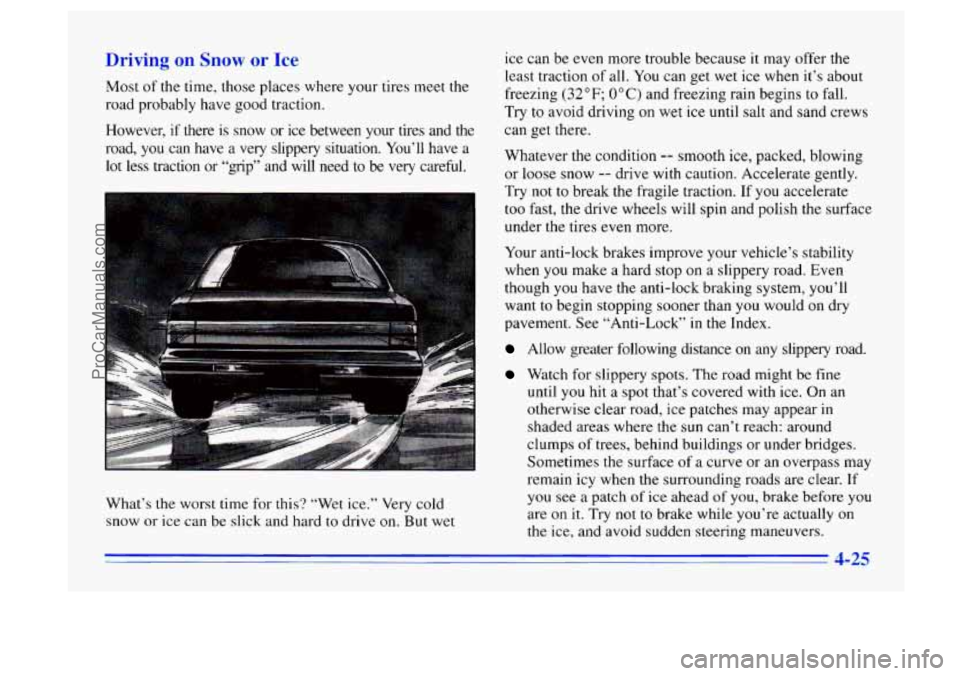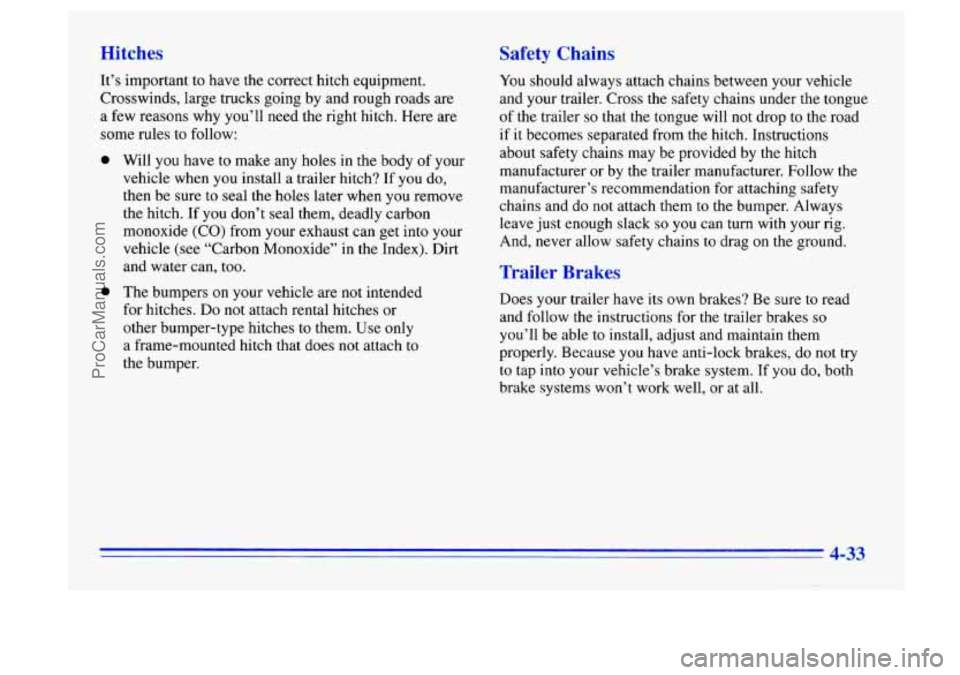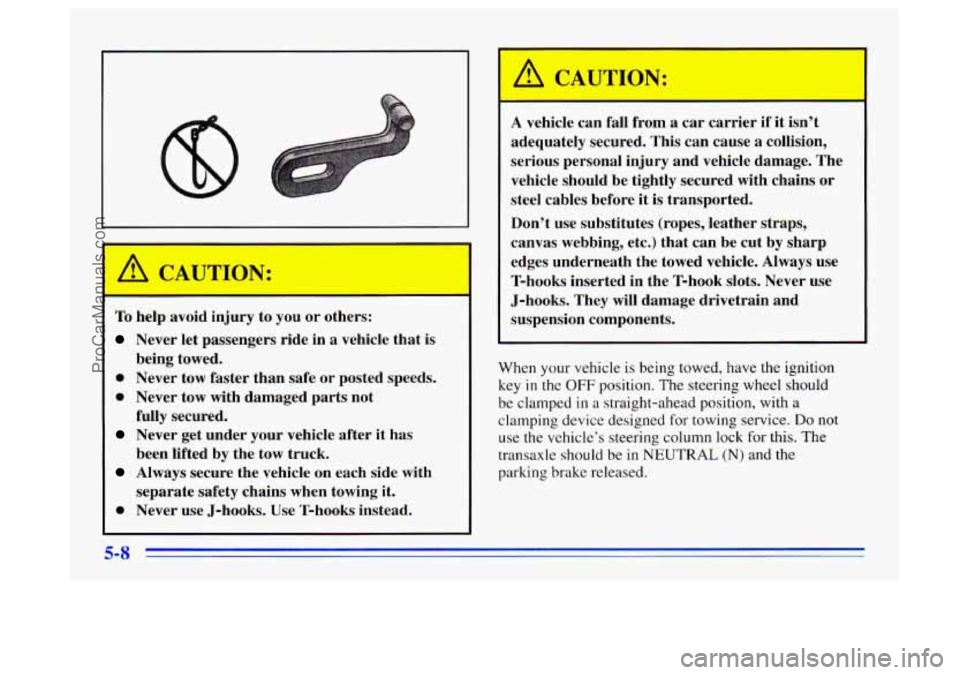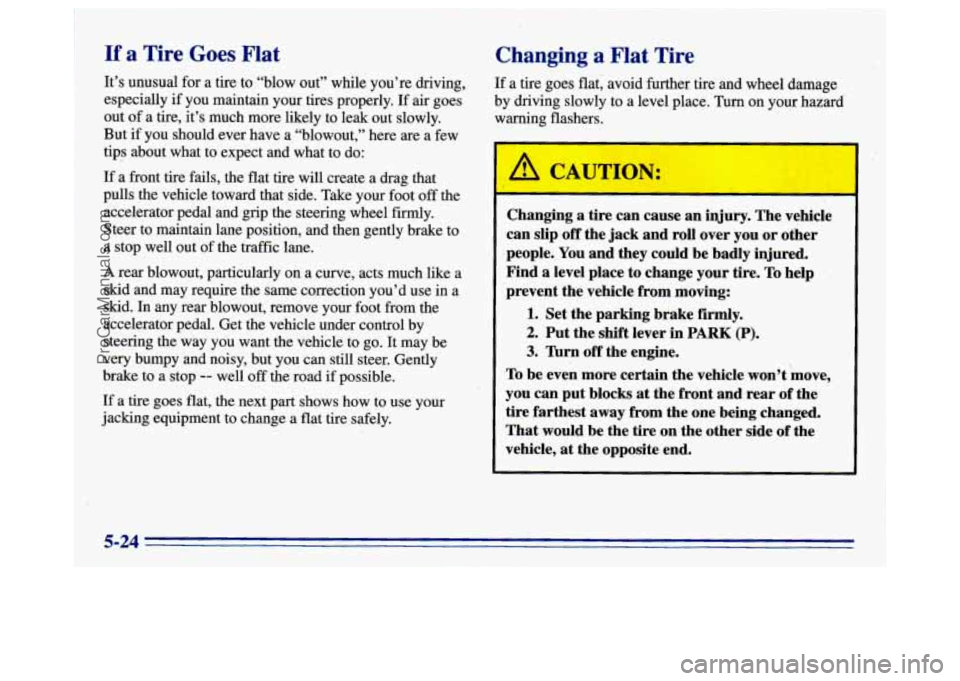Page 155 of 340

Driving on Snow or Ice
Most of the time, those places where your tires meet the
road probably have good traction.
However, if there is snow or ice between your tires and the
road, you can have a
very slippery situation. You’ll have a
lot less traction or “grip” and will need
to be very careful.
What’s
the worst time for this? “Wet ice.” Very cold
snow or ice can be slick and hard to drive on. But wet ice
can be
even more trouble because it may offer the
least traction of all. You can get wet ice when it’s about
freezing
(32°F; 0°C) and freezing rain begins to fall.
Try to avoid driving on wet ice until salt and sand crews
can get there.
Whatever the condition
-- smooth ice, packed, blowing
or loose snow
-- drive with caution. Accelerate gently.
Try not to break the fragile traction.
If you accelerate
too fast, the drive wheels will spin and polish the surface
under the tires
even more.
Your anti-lock brakes improve your vehicle’s stability
when you make
a hard stop on a slippery road. Even
though
you have the anti-lock braking system, you’ll
want to begin stopping sooner than
you would on dry
pavement. See “Anti-Lock” in the Index.
Allow greater following distance on any slippery road.
Watch for slippery spots. The road might be fine
until you hit a spot that’s covered with ice. On an
otherwise clear road, ice patches may appear in
shaded areas where the sun can’t reach: around
clumps
of trees, behind buildings or under bridges.
Sometimes the surface
of a curve or an overpass may
remain icy when the surrounding roads are clear. If
you see a patch of ice ahead of you, brake before you
are on it. Try not to brake while you’re actually on
the ice, and avoid sudden steering maneuvers.
4-25
ProCarManuals.com
Page 157 of 340

Snow can trap exhaust gases under your vehicle.
This can cause deadly CO (carbon monoxide) gas
to get inside. CO could overcome you and kill
you. You can’t see !it or smell it,
so you might not
know it
is in your vehicle. Clear away snow from
around the base of your vehicle, especially any
that is blocking ‘your exhaust pipe. And check
around again from time
to time to be sure snow
doesn’t collect there.
Open a window just a little on the side of the
vehicle that’s away from the wind.
This will help
keep
CO out.
Run your erigine only as long as you must. This saves
fuel. When you run the engine, make it go a little faster
than just idle. That is, push the accelerator slightly.
This
uses less fuel for the heat that you get and it keeps the
battery charged. You will need a well-charged battery
to
restart the vehicle, and possibly for signaling later on
with your headlamps. Let the heater run for awhile.
Then, shut the engine
off and close the window almost
all the way to preserve the heat. Start the engine again
and repeat this
only when you feel really uncomfortable
from the cold. But
do it as little as possible. Preserve the
fuel as long as you can.
To help keep warm, you can get
out of the vehicle and do some fairly vigorous exercises
every half hour
or so until help comes.
ProCarManuals.com
Page 163 of 340

Hitches Safety Chains
You should always attach chains between your vehicle
and your trailer. Cross the safety chains under the tongue
of the trailer
so that the tongue will not drop to the road
if it becomes separated from the hitch. Instructions
about safety chains may be provided by the hitch
manufacturer or by the trailer manufacturer. Follow the
manufacturer’s recommendation for attaching safety
chains and do not attach them to the bumper. Always
leave just enough slack so you can turn with your rig.
And, never allow safety chains to drag on the ground.
It’s
important to have the correct hitch equipment.
Crosswinds, large trucks going by and rough roads are a few reasons why you’ll need the right hitch. Here are
some rules to follow:
0
0
Will you have to make any holes in the body of your
vehicle when
you install a trailer hitch? If you do,
then be sure
to seal the holes later when you remove
the hitch. If you don’t seal them, deadly carbon
monoxide (CO) from your exhaust can get into your
vehicle (see “Carbon Monoxide” in the Index). Dirt
and water can, too.
The bumpers
on your vehicle are not intended
for hitches. Do not attach rental hitches
or
other bumper-type hitches to them. Use only
a frame-mounted hitch that does
not attach to
the bumper.
Trailer Brakes
Does your trailer have its own brakes? Be sure to read
and follow the instructions for the trailer brakes
so
you’ll be able to install, adjust and maintain them
properly. Because you have anti-lock brakes, do not try
to tap into your vehicle’s brake system.
If you do, both
brake systems won’t work well, or at all.
4-33
ProCarManuals.com
Page 174 of 340

To help avoid injury to you or others:
Never let passengers ride in a vehicle that is
0 Never tow faster than safe or posted speeds.
0 Never tow with damaged parts not
fully secured.
Never get under your vehicle after it has
been lifted by the tow truck.
Always secure the vehicle on each side with
separate safety chains when towing it.
0 Never use J-hooks. Use T-hooks instead.
being
towed.
U
A vehicle can fall from a car carrier if it isn’t
adequately secured. This can cause
a collision,
serious personal injury and vehicle damage. The
vehicle should be tightly secured with chains or
steel cables before it is transported.
Don’t use substitutes (ropes, leather straps,
canvas webbing, etc.) that can be cut by sharp
edges underneath the towed vehicle.
Always use
T-hooks inserted in the
T-hook slots. Never use
J-hooks. They will damage drivetrain and
suspension components.
When your vehicle
is being towed, have the ignition
key
in the OFF position. The steering wheel should
be clamped
in a straight-ahead position, with a
clamping device designed for towing service. Do not
use the vehicle’s steering column lock for this. The
transaxle should be in NEUTRAL (N) and the
parking brake released.
5-8
ProCarManuals.com
Page 176 of 340
2. Position a 4”x 4” wood beam across sling chains
with spacer blocks contacting the forward extensions
of the engine cradle.
5-10
3. Position the lower sling crossbar halfway between
the timber and the lower edge
of the fascia.
ProCarManuals.com
Page 186 of 340
How to Add Coolant to the Radiator
I NOTICE:
r
Your engine has a specific radiator fill procedure.
Failure to
follow this procedure could cause your
engine to overheat and be severely damaged.
1. You
can remove the
radiator pressure cap
when the cooling
system, including the
radiator pressure cap and
upper radiator hose, is no longer hot.
2. Then keep turning
the pressure cap,
but
now push down as you
turn it. Remove the
pressure cap.
Turn the pressure cap slowly counterclockwise until
it first stops. (Don’t press down while turning
the
pressure cap.)
If you hear a hiss, wait for that to stop. A hiss means
there
is still some pressure left.
,A CAUTION:
You can be burned if you spill coolant on hot
engine parts. Coolant contains ethylene glycol
and it will burn if the engine parts are hot
enough. Don’t spill coolant on a hot engine.
5-20
ProCarManuals.com
Page 190 of 340

If a Tire Goes Flat
It’s unusual for a tire to “blow out” while you’re driving,
especially
if you maintain your tires properly. If air goes
out of a tire, it’s much more likely to leak out slowly.
But
if you should ever have a “blowout,” here are a few
tips about what to expect and what to do:
If a front tire fails, the flat tire will create a drag that
pulls the vehicle toward that,side. Take your foot
off the
accelerator pedal and grip the steering wheel fely.
Steer to maintain lane position, and then gently brake to
a stop well out of the traffic lane.
A rear blowout, particularly on a curve; acts much like a
skid and may require
the same correction you’d use in a
skid. In any rear blowout, remove your foot from the
accelerator pedal. Get the vehicle under control by
steering the way you want the vehicle to
go. It may be
very bumpy and noisy, but you can still steer. Gently
brake to a
stop -- well off ‘the road if possible.
If a tire goes flat, the next part shows how to use your
jacking equipment to change a flat tire safely.
Changing a Flat Tire
If a tire goes flat, avoid further tire and wheel damage
by driving slowly to a level place. Turn on your hazard’
warning flashers.
I
Changing a tire can cause an injury. The vehicle
can slip
off the jack and roll over you or other
‘people. You and they could be badly injured.
Find a level place to change your tire. To help
prevent the vehicle from moving:
1. Set the parking brake firmly.
2. Put the shift lever in PARK (P).
3. ”urn off the engine.
To be even more certain the vehicle won’t ‘move,
you can put blocks at the front and rear of the
tire farthest away from the one being changed.
That would be the tire on the other side of the
vehicle,
at the opposite end.
ProCarManuals.com
Page 192 of 340
Sedan
The equipment you’ll need is stored in the trunk.
1. Pull the carpeting from the floor of the trunk.
2. Turn the center retainer bolt on the compact spare
tire housing counterclockwise to remove it, then lift
the tire cover.
3. Lift off the jack and remove the spare tire.
4. Remove the wheel wrench from the bag.
5-26
ProCarManuals.com